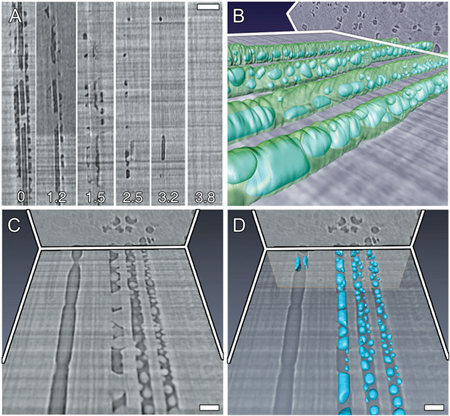ALS user Andrew McElrone’s research on grapevine rootstock water transport physiology is key to the future of California’s grape-growing industry. The plant biologist’s ultimate goal is to develop sustainable water use strategies for growers, giving them hard data about how much drought their plants can sustain and which species are ideal for an agricultural future with an uncertain water supply.
McElrone, an adjunct faculty member in the Department of Viticulture and Enology at UC Davis, is a Research Scientist with the USDA-Agricultural Research Service, which supplies base funding for his work at the ALS. He also receives research grants from the agricultural industry – most recently the Specialty Crops Research Initiative and the American Vineyard Foundation. His research partnerships include some companies with a big stake in the grape-growing industry, including Gallo, Sun-Maid, Welch’s, Chateau Ste. Michelle, and J. Lohr.

In his two years of research on ALS Beamline 8.3.2, McElrone has used high resolution computed tomography—a type of cat scan similar to the medical imaging diagnostic system—to gain a better understanding of a grapevine’s water transport system. The superior resolution of the scans allowed McElrone and his research partners to see for the first time exactly how pressure from drought affects xylem vessels within a plant’s water transport network. The xylem network transports water and nutrients from the roots to the rest of a plant—the more drought the network withstands, the more tension there is in the system and the more susceptible the individual vessels and tubes are to breakage, or cavitation.
What McElrone discovered through his work at the ALS is that some grapevines can actually repair this breakage through droplet formation along the walls of the xylem tubes. Scientists had speculated about this process, but McElrone and his fellow researchers were the first to actually watch the process and observe that droplet formation occurred not in a random formation but rather followed the orientation of remaining living cells. McElrone is now continuing this research with a variety of grapevine species, theorizing that the more drought-resistant ones have the ability to actually resist breakage or possess superior repair capabilities.
“Our eventual goal is to figure out how far we can push various species of grapevine before they break, which we can then apply to water usage in the fields,” says McElrone. “At the ALS, we can actually watch the breakage and the repair occurring.”
Another major finding to emerge from McElrone’s beamline research is that grapevines’ bridge cells, which create better network connectivity within the plants’ vascular architecture, also determine which species are most resistant to pathogens. Via high-resolution electron microscopy (EM) scans at UC Davis paired with scans at the ALS, McElrone’s team observed the presence and orientation of bridge cells. Additional EM work was used to see if there were intact barriers between bridge cells. More susceptible grapevines had more bridge cells and the individual bridge cells were open, allowing the pathogen to pass through the network and further into the plant structure. The resistant species could actually isolate the pathogens by building bridge cells with barriers, halting the spread of the bacteria. McElrone conducted the bridge cell studies with fellow researcher Craig Broderson, currently at the University of Florida at the Citrus Research Center, who is now applying the results to other crops.
“As far as plant biology goes, this is as sexy as it gets in terms of the images we’re getting,” says McElrone.